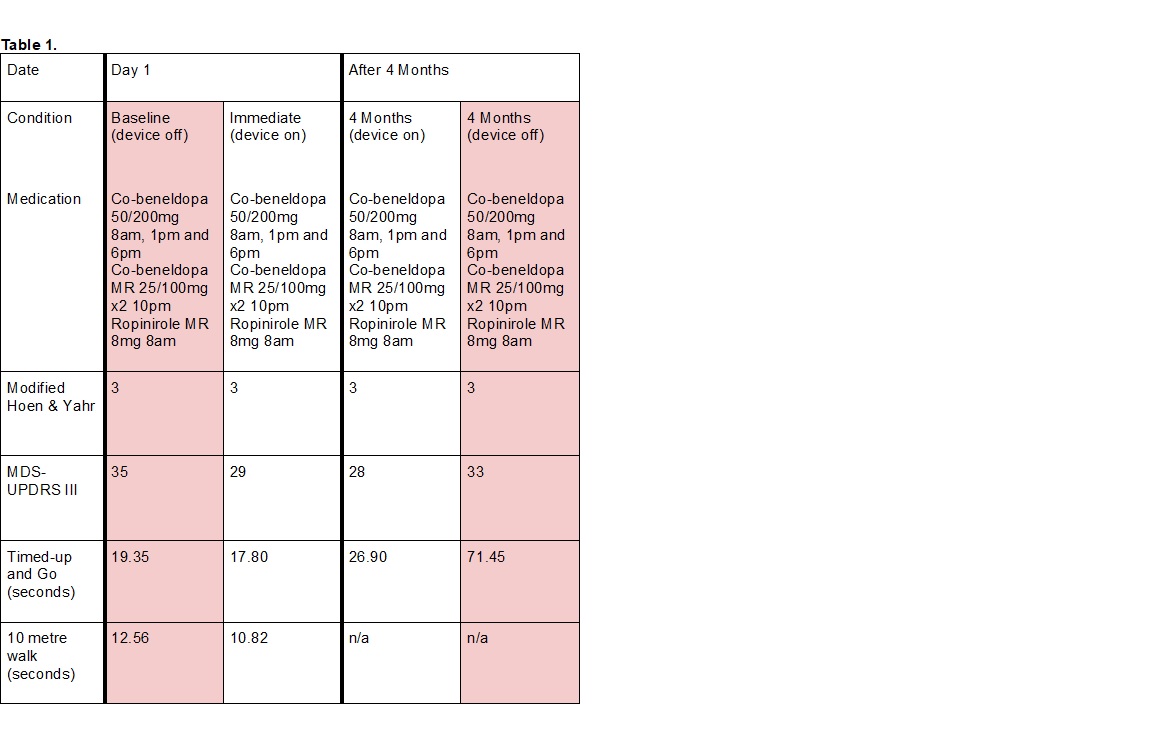Category: Technology
Objective: To document motor symptoms of a patient with PD whilst using a Focussed Vibrotactile Stimulation and Cueing Device (FVCD).
Background: A 77-year-old patient with PD and rapidly progressive freezing of gait (FOG) with a muted response to pharmacological therapy (PSP was excluded) consented to trial a FVCD. He was provided with a non-invasive, wearable medical device which utilises vibrotactile stimulation and cueing to improve motor function (1). Cueing is reported to work by shifting habitual motor control to goal directed motor control (2). Motor symptoms in PD may be driven by abnormally synchronised oscillatory activity at multiple levels of the basal ganglia–cortical loop (3) and vibrotactile stimulation may enhance movement speed by increasing preparatory beta desynchronisation (4).
Method: The patient was fitted with the FVCD to his sternum (settings: vibration strength 80%, pulse length 800ms, rest length 800ms). Pre-intervention he underwent an assessment of his motor function: MDS-UPDRS III, timed up-and-go (TUG) and 10 metre walk test. This assessment was repeated 20 minutes post device fitting. The device was used daily during waking hours. Device settings were optimised after 2 months (VS 80%, PL 700ms, RL 500ms). Further assessment of motor function was completed at 4 months (MDS-UPDRS III and TUG).
Results: Baseline MDS-UPDRS III = 35 and this improved to 29 (MDS-UPDRS III -6) after device acclimatisation. Improvement was maintained at the 4 month follow up visit MDS-UPDRS III = 28 (MDS-UPDRS III -7). Motor function immediately deteriorated with the device off. TUG improved with device use on both testing occasions but there was an overall deterioration in TUG over the 4-month period. A 15% increase in his walking speed was noted at the baseline visit. No adverse effects were reported.
Conclusion: Over the 4-month study period there was a sustained improvement in MDS-UPDRS III with use of the FVCD. The improvement was greater MCID of -3.25 (5). MDS-UPDRS III score immediately deteriorated to baseline when the device was switched off. The patient had improvement in his TUG score but still had significant issues with his severe progressive FOG. This novel device represents a safe adjunct to potentially improve motor symptoms in patients with poor response to pharmacological therapy. Further research is required.
References: 1. Wilhelm, A., Riedl, T., Paumann, C., & Janssen, J. (2022). Exploring a New Cueing Device in People Who Experience Freezing of Gait: Acceptance of a Study Design. Parkinson’s Disease, 2022.
2. Redgrave, P., Rodriguez, M., Smith, Y., Rodriguez-Oroz, M. C., Lehericy, S., Bergman, H., … & Obeso, J. A. (2010). Goal-directed and habitual control in the basal ganglia: implications for Parkinson’s disease. Nature Reviews Neuroscience, 11(11), 760-772.
3. Hammond, C., Bergman, H., & Brown, P. (2007). Pathological synchronization in Parkinson’s disease: networks, models and treatments. Trends in neurosciences, 30(7), 357-364.
4. Macerollo, A., Palmer, C., Foltynie, T., Korlipara, P., Limousin, P., Edwards, M., & Kilner, J. M. (2018). High‐frequency peripheral vibration decreases completion time on a number of motor tasks. European Journal of Neuroscience, 48(2), 1789-1802.
5. Horváth, K., Aschermann, Z., Ács, P., Deli, G., Janszky, J., Komoly, S., & Kovács, N. (2015). Minimal clinically important difference on the Motor Examination part of MDS-UPDRS. Parkinsonism & related disorders, 21(12), 1421-1426.
To cite this abstract in AMA style:
A. Mackett. Case report on the use of a High Frequency Vibrotactile Stimulation and Cueing Device over 4 months in a patient with Parkinson’s Disease and refractory symptoms [abstract]. Mov Disord. 2023; 38 (suppl 1). https://www.mdsabstracts.org/abstract/case-report-on-the-use-of-a-high-frequency-vibrotactile-stimulation-and-cueing-device-over-4-months-in-a-patient-with-parkinsons-disease-and-refractory-symptoms/. Accessed December 30, 2025.« Back to 2023 International Congress
MDS Abstracts - https://www.mdsabstracts.org/abstract/case-report-on-the-use-of-a-high-frequency-vibrotactile-stimulation-and-cueing-device-over-4-months-in-a-patient-with-parkinsons-disease-and-refractory-symptoms/

